
Why Your Garden Needs Golden Barrels
In my video Why a Succulent Garden Needs Golden Barrels (1:35), Jeanne Meadow tells why she's glad her landscape architect talked her into them. She now has 30+ in her famed Southern CA succulent garden.
Scroll down to browse my Gallery of Golden Barrels in Gardens and Landscapes below.
Chances are you've seen golden barrel cactus in professionally designed succulent gardens, but you've hesitated to add it to yours. Here's why you should, and how to keep the plants happy. But first a reassurance: Yes it's spiny, but the spines curve downward. IMHO, its plusses far outweigh any minuses.

My neighbor Elisabeth Crouch demonstrates how to hold a barrel cactus: Wear tough garden gloves, grasp it by its roots, and cushion the plant with a folded newspaper.
Golden barrels take a garden from mundane to amazing. Here's why.
- Texture. From a distance they look like fuzzy balls. Up close they look spiky. Either way they're an intriguing contrast to nearby foliage.
- Shape. I'm betting no other plants in your garden are spherical. Ball-shaped cacti show to advantage in groupings or S-curves.
- Interest. A solo barrel serves as a focal point. More than one suggests rolling terrain.
- Color. Their sunny yellow stands out and repeats that of other shrubs and succulents.
- Light. When backlit by early morning or late afternoon sun, translucent spines glow.

Golden barrels and silver swords (Cleistocactus strausii) light up a backyard. Squint at the photo and imagine it without them. Doesn't look like much, does it?
About golden barrel cactus
In the wild, Echinocactus grusonii grows on rocky, volcanic slopes at 4600 feet in the Mexican state of Hidalgo. It's rare and endangered due to over-harvesting and from the building of a reservoir that destroyed much of its habitat.
Barrels lean in the direction of greatest light. This is most noticeable in older specimens, which become cylindrical over time. Spines and ribs help shade and protect the plant's thin green skin. Btw, the term "barrel cactus" applies to other rotund genera, primarily Ferocactus.

Barrels at the Huntington Botanical Gardens lean slightly to the southwest. "Throughout the garden are more than 500 specimens of golden barrel cactus," says the guidebook Desert Plants of the Huntington Botanical Garden, by curator Gary Lyons. "...the largest specimens were grown from seed in the early 1920s and planted in 1929."
It takes about 30 years for barrels to reach maturity (3-1/2 feet in diameter with 35 ribs). Clusters will of course fill more space. Specimens at the Huntington Botanical Gardens are immense due to great age (50+ years).
See my video: How Old is that Barrel Cactus? (2:03) I harvest seeds from a 35-year-old specimen and show how the plants change as they age.
Golden barrels usually don't flower until they're about 14 inches across. Approximate growth rate is an inch per year. In spring, satiny yellow flowers form a whorl around the plant's wooly crown.

Barrel cactus flowers suggest Reese's Pieces.
Crisp dry petals hide fruit imbedded in the wool. The fruit dries into seed pods that are easily wiggled loose. When pulled out, cottony tufts cling to them.
How to grow golden barrels
The plants are well suited to warm, dry, sunny areas of southern and coastal CA from the Bay Area south, northern Mexico, and (given some shade) Arizona, New Mexico and southern Texas.
Sun exposure: Give full sun in all but desert climates. The more sun, the darker gold the spines. When transplanting, give a barrel the same orientation to the sun as it had previously, or its skin may burn (mark the pot).
Temperature: Golden barrels prefer average minimum temperatures in the low 50s F, but can tolerate 15 F for brief periods.
Location: Don't plant any cactus where it'll encroach on steps or walkways, or areas children or dogs play. Place barrels on a slight slope to enhance drainage but not on an incline so steep that their weight may cause them to tumble. Set atop mounded soil with thirstier plants lower. Avoid planting under trees; leaf litter is difficult to remove.

Golden barrel cactus, well away from a walkway, grows in a lava-rock terrace.
Plan ahead: It's best if, once planted, golden barrels stay put. By the time a specimen is 2 feet across, it weighs well over 100 lbs.
Water: Like many cacti, barrels like an occasional deep soaking during hot, dry summer months. This helps them grow faster, but without it they'll survive on stored moisture. Water at the base with a hose or drip irrigation.
Soil: Use a coarse, fast-draining mix of 20 to 40 percent organic compost and 80 to 60 percent decomposed granite sand or crushed lava rock.

With one hand he'll lift and carry the plant by the hose he's cinched around it, and with the other he'll use the shovel to balance and steady it.
Digging and transplanting: Elevate the plant's shallow roots with a shovel then use an old, soft garden hose to lasso and carry it so you don't break its spines. At its new location, gently secure the plant atop a shallow basin. Wait two weeks to water a newly planted barrel. Roots, which break easily and may be crushed by the weight of the plant, need time to heal.
Troubleshooting: If barrels get wet and cold they may rot. Don't plant one where rainwater collects. [See my video: Why Succulents Rot and How to Prevent It (2:02).] Barrels are not prone to pests, but gophers may occasionally eat all the way up into the core of the plant.
Weeding: Use long tweezers to remove weeds. [See my video: How to Weed a Spiky Succulent (2:59).] Before winter rains, apply an environmentally friendly pre-emergent herbicide to the ground around the plants to prevent weed seeds from germinating.
Propagation by offsets
To stimulate a barrel cactus to produce offsets, take a nail that's 3 or 4 inches long, hold it with pliers, heat it over a flame, and push it into a growing point (where spines emerge) to half the nail's length, and then remove it. Or use a power drill to core the plant. [See how it's done in my video, Succulent Propagation by Coring (4:01).]

Having its core destroyed by a gopher stimulated this barrel cactus to produce offsets.
To remove an offset, grasp it with rubber-tipped tongs and gently twist. Wait a few days until the raw end is dry and hard, then nestle the baby plant in coarse, well-draining soil.
Where to buy golden barrels

Golden barrel with offset at Desert Theater nursery north of San Diego
Many succulent nurseries in Southern CA carry golden barrels in one-gallon pots and larger or can order them for you. Obtain smaller specimens online via Amazon and Mountain Crest Gardens.
Golden barrels in gardens and landscapes
Barrels are dramatic and draw the eye, so know the look you want before planting. Repeat them to lend design continuity to a garden. For a natural look, don't place barrels equidistant from each other or line them up in rows. On the other hand, deliberately creating a pattern with them can be striking.
For a modern, minimalist effect, surround barrels with rocks. It's fine to combine them with soft-leaved succulents, but keep in mind such floral-style plantings are temporary. The barrels will be there long after the sedum, echeverias or senecios have become tired, overgrown and need replacing.




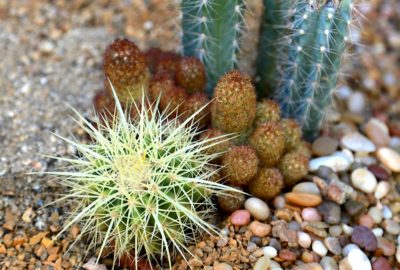

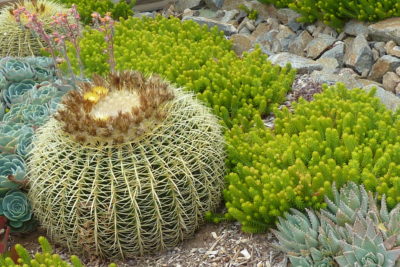

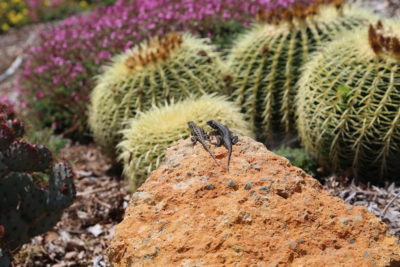














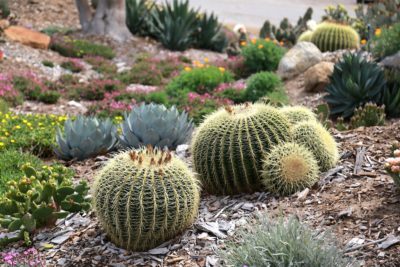



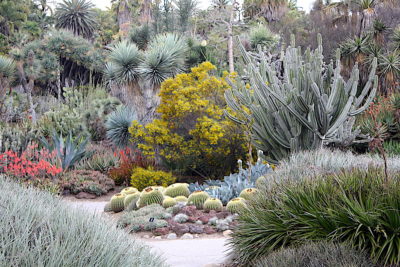





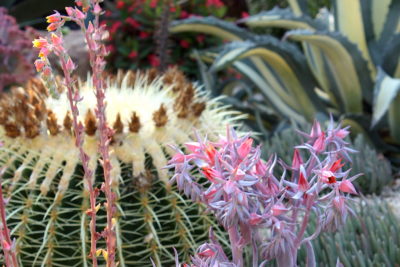
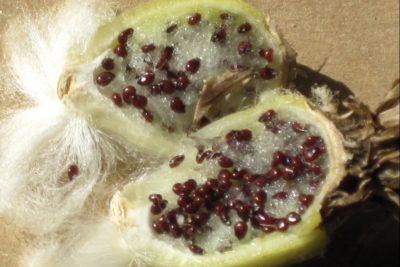





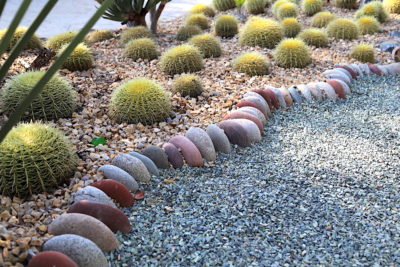





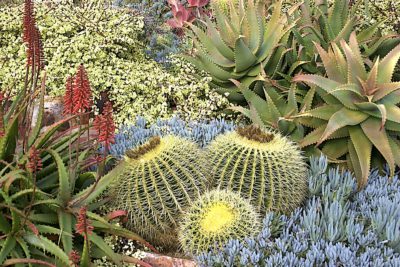





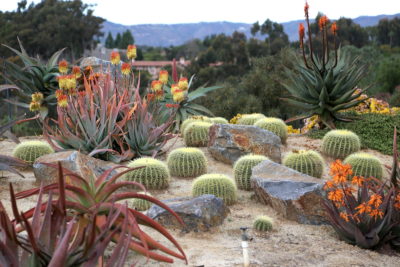




I love golden barrels. Really enjoy reading this article. Thank you
I’m in Central Victoria Australia and have a golden barrel in a shallow pot. They’re quite expensive here and I purchased mine when it was just a few inches across. Its grown to about a foot across in 15 years. It has survived from below freezing to 46 degrees celsius in full sun. Never flowered. I’ve just repotted it and used a chunk of polystyrene in each hand to lift it from its pot – worked well! I’d like to put it in the garden but I’m too scared!
I don’t blame you — you have a lot of time and money invested in it. Since it’s still a manageable size, consider giving it its forever home. If it’s safe from rot, pests and temps below 15 degrees F, it should be fine.
I wholeheartedly agree that golden barrel cactus is needed in the garden. In 2015 I replaced my small front lawn in Simi Valley, CA with about 45 golden barrel cactus of various sizes. The sunlight shining on these beautiful plants is truly an amazing sight that gives me satisfaction knowing that I made the right choice in my garden.
A problem with golden barrel cactus is the way those insidious weeds grow underneath the spines and between the ridges of the plant.
Weeding is a challenge!
Hi David — Around the bases of barrels I spread “pre-emergent,” a granular herbicide that prevents weeds from germinating. (One brand is Preen.) You have to apply it before the rains, because once weeds sprout, it’s too late. I wouldn’t be without it. As to its environmental impact, I checked with the director of horticulture at the San Diego Botanic Garden, and he’s fine with it, in fact, they use it too.
If you already have weeds, extract them with long-handled tweezers, a hand weeder with a V-shaped metal tip, or—recommended by the Ruth Bancroft Garden for weeding around cactus—a Stainless Steel Fish Hook Remover Extractor, around $8 on Amazon. — Debra
Thank you, Debra. I’m always concerned about using chemicals, but I will give the pre-emergent a try. I use long-nosed pliers, fish-hook
removers, tweezers and hemostats, but hoping the pre-emergent will eliminate most of the weeding in the future. Thanks again. David
Hi Debra,
How are you?
Please share your garden water drainage system,so that I can get an idea regarding this.
Thanks,
Harry Brent
Hi Harry — Most of my garden is in terraces or sloping ground. So water naturally percolates downward. If you have a flat garden, you can replicate my ideal drainage with raised beds and mounded soil.
thank you for the information–should I remove the brown seed pods atop of the barrel?
Hi Kelly — It’s an aesthetic decision. Some people remove them because it makes the barrels more tidy. You can also open the tufts, remove the seeds and use them to start new plants. One homeowner told me that seeds fall into lower parts of the plant and take root—right into the mother plant—which causes offsets. I’d love to know if it’s possible. I’ve assumed that the offsets, or baby barrels, are a natural-occurring phenomenon, like branching.
We live in Scottsdale, AZ. Have several golden barrels in our landscape. All of a sudden one of them has baby plants all over the top of it. We have never seen this before??
Something must have stimulated the meristem tissue along the ribs. Possibly abrasion of some sort. Congratulations, Grandma!
My golden barrel mammalaria has been eaten by a gopher on the inside of two of the globes. Maybe it’s several plants ( or not). Is there any hope for it? Or do I just wait and see what survives? It’s too large to dig up or even maybe too big to remove the two affected globes. Have had in the ground about 10 years. It’s huge. Several globes about a foot across. It bloomed for the first time this year. I’ve saved the seeds just In case.
Hi Linda — That’s a shame. It may be OK if it still has some roots. It will likely produce offsets, like damaged golden barrels tend to do. I hope you caught the gopher!
I am glad to hear about coring procedure. Since grusonni does not flower easily, I was wondering as to how I can get more plants in a short while. I live in Lesotho in the southern temperate zone of Africa. My two plants have adjusted so well, I want to try coring on one. Wish me luck.
Hi Debra – two notes: we have voles in our garden that already cored-out 2 agaves and one yucca, and i looked to see if you had any info on the beasts – saw info on gophers but not voles.
Second, i bought a golden barrel and wondered if I was wrong to think it could live outside all year round. I’m in the South of France and while we are technically a zone 9, we’re in the foothills of mountains where we can get freezing temps (and below) – though only at night – during the winter. (so a micro climate of zone 8?) Rarely snows, however. Do you think a frost cloth is enough along with stone mulch at the roots, or should i bring it in during the winter? She’s big and heavy about 40 cms across.
Thank you!
Holly
Hi Holly — I hesitate to speak about a pest I haven’t encountered—so to answer your question I rely on the same info you can find yourself. But I did a brief search and lo and behold, we do have voles in Southern CA. Fortunately they haven’t found my garden. If/when they do, I’ll probably set traps or bait. I have had no problem with frost getting my golden barrels, but they sure are sensitive to too much rain. Make sure yours are in coarse, well-draining soil. Position them at the top of a berm or grow in a shallow pot. And remember, these are desert plants. If you don’t live in a desert, you have to try and replicate that environment as much as possible to keep cacti alive. Try tenting them, too, like they do at the Jardin Zoologique Tropical…which I did a blog post about, with photos that show the garden’s barrel cactus. https://debraleebaldwin.com/caring-for-succulents/succulents-and-too-much-rain-what-to-do/
Hello, Debra, I have been growing a set of 13-15 golden barrels in a small 3″x9″ cement planter since March of this year. They have been growing indoors under a 15W grow light in an air conditioned home of about 70 degrees, watering them about once a week, at this age. At the time of this message, they are each about a centimeter in size. Eventually, I want to move these to an outdoor garden bed that can be moved if needed. I live in the Piedmont area of NC and it is humid, which is good for them, but it rains pretty frequently. So I do not want these babies to become drowned easily. What would you advise for a transition from an indoor setting to an outdoor setting with rain and 90 degree summer temp, 20 degree winter temp? I can also respond with photos of the progress if you need. Thank you so much! -Chris
Hi Chris — Barrel cacti are native to the desert Southwest and Mexico, which I imagine is very different from the Piedmont area of North Carolina. I live in Southern CA, inland from the ocean, with a climate that barrels do well in, and they still rot if they get too much rain. Consider: They are water-storing tanks with roots that grab water when it’s available and don’t know what to do with too much. You say “humid is good for them” but humidity means they won’t dry adequately. “It rains pretty frequently” also can lead to rot. They’re fine with 90 degrees and can handle frost into the mid-20s, but rain and humidity? No, except perhaps in a climate-controlled greenhouse. That said, there are wonderful exotic plants (not necessarily succulents) you can grow that I can’t. Check out the selection at Plant Delights Nursery in Raleigh. I’ve always wanted to go there! I get their catalog. Very cool stuff.